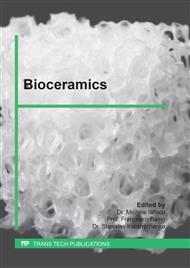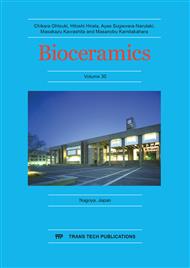[1]
S.F. Cohen and R.C. Burns, Pathways of The Pulp, 8th ed., Mosby Inc., St. Louis, (2002).
Google Scholar
[2]
T. Komabayashi, Q. Zhu, E. Robert, I. Yohji, Current Status of Direct Pulp-Capping Materials for Permanent Teeth, Dent. Mater. J. 35(1) (2016) 1-12.
DOI: 10.4012/dmj.2015-013
Google Scholar
[3]
M.N. Zakaria, A. Cahyanto, A. El-Ghannam, Basic Properties of Novel Bioactive Cement Based on Silica-Calcium Phosphate Composite and Carbonate Apatite, Key Eng. Mater. 720 (2017) 147-152.
DOI: 10.4028/www.scientific.net/kem.720.147
Google Scholar
[4]
M.N. Zakaria, N.F.N. Pauziah, I.P. Sabirin, A. Cahyanto, Evaluation of carbonate apatite cement in inducing formation of reparative dentin in exposed dental pulp, Key Eng. Mater. 758 (2017) 250-254.
DOI: 10.4028/www.scientific.net/kem.758.250
Google Scholar
[5]
D.S Pathak, P. V. Bansode, M. B. Wavdhane, S. Khedgikar, P. P. Birage, Advances in Pulp Capping Materials: A Review, IOSR J. Dent. Med. Sci. 16(2) (2017) 31–37.
Google Scholar
[6]
M.G. Gandolfi, F. Siboni, T. Botero, M. Bossu, F. Riccitiello, C. Prati, Calcium silicate and calcium hydroxide materials for pulp capping: biointeractivity, porosity, solubility and bioactivity of current formulations, J. Appl. Biomater. Funct. Mater. 13 (2015).
DOI: 10.5301/jabfm.5000201
Google Scholar
[7]
A. Qureshi, E. Soujanya, N. Numar , P. Kumar , S. Hivarao, Recent Advances in Pulp Capping Materials: An Overview, J. Clin. Diagn. Res. 8(1) (2014) 316-321.
Google Scholar
[8]
T. J. Hilton, Keys to Clinical Success with Pulp Capping: A Review of the Literature, Oper. Dent. 34(5) (2009) 615–625.
DOI: 10.2341/09-132-0
Google Scholar
[9]
L.C. Natale, M.C. Rodrigues, T.A. Xavier, A. Simoes, D.N. de Souza, R.R. Braga, Ion Release and Mechanical Properties of Calcium Silicate and Calcium Hydroxide Materials Used for Pulp Capping, Int. Endo. J. (2014) 1-6.
DOI: 10.1111/iej.12281
Google Scholar
[10]
S.V. Dorozhkin, Calcium Orthophosphate Cements and Concretes, Materials. 2(1) (2009) 221-291.
DOI: 10.3390/ma2010221
Google Scholar
[11]
A. Cahyanto, K. Tsuru, K. Ishikawa. Transformation of apatite cement to B-type carbonate apatite using different atmosphere, Key Eng. Mater. 696 (2016) 9-13.
DOI: 10.4028/www.scientific.net/kem.696.9
Google Scholar
[12]
A. Cahyanto, M. Maruta, K. Tsuru, K. Ishikawa, and S. Matsuya, Basic Properties of Carbonate Apatite Cement Consisting of Vaterite and Dicalcium Phosphate Anhydrous, Key Eng. Mater. 530 (2016) 192-196.
DOI: 10.4028/www.scientific.net/kem.529-530.192
Google Scholar
[13]
A. Cahyanto, M. Maruta, K. Tsuru, S. Matsuya, K. Ishikawa, Fabrication of bone cement that fully transforms to carbonate apatite, Dent. Mat. J. 34 3 (2005) 394-401.
DOI: 10.4012/dmj.2014-328
Google Scholar
[14]
A. Cahyanto, R. Toita, K. Tsuru, K. Ishikawa, Effect of Particle Size on Carbonate Apatite Cement Properties Consisting of Calcite (or Vaterite) and Dicalcium Phosphate Anhydrous, Key Eng. Mater. 631 (2015) 128-133.
DOI: 10.4028/www.scientific.net/kem.631.128
Google Scholar
[15]
A. Cahyanto, E. Megasari, M.N. Zakaria, N. Djustiana, Sunarso, K. Usri, D. Aripin, S. Tjahayawati, M.S. Mariam, S.S. Widyaputra, Fabrication of carbonate apatite cement as endodontic sealer, Key Eng. Mater. 758 (2017) 61-65.
DOI: 10.4028/www.scientific.net/kem.758.61
Google Scholar
[16]
A. Cahyanto, A. Rezano, M.N. Zakaria, A. El-Ghannam, Synthesis and Characterization of a Novel SCPC-CO3Ap Cement for Pulp Capping Application in Dentistry, Key Eng. Mater. 758 (2017) 29-33.
DOI: 10.4028/www.scientific.net/kem.758.29
Google Scholar
[17]
F. Daitou, M. Maruta, G. Kawachi, K. Tsuru, S. Matsuya, Y. Terada, K. Ishikawa, Fabrication of carbonate apatite block based on internal dissolution-precipitation reaction of dicalcium phosphate and calcium carbonate. Dent. Mater. J. 29(3) (2010).
DOI: 10.4012/dmj.2009-095
Google Scholar
[18]
A. Cahyanto, K. Tsuru, K. Ishikawa. Carbonate apatite formation during the setting reaction of apatite cement. Advances in Bioceramics and Porous Ceramics V. Ceramics Engineering and Science Proceeding 33 6 (2013) 7-10.
DOI: 10.1002/9781118217504.ch2
Google Scholar
[19]
A. Cahyanto, K. Tsuru, K. Ishikawa and M. Kikuchi. Mechanical strength improvement of apatite cement using hydroxyapatite/collagen nanocomposite, Key Eng. Mater. 720 (2017) 167-172.
DOI: 10.4028/www.scientific.net/kem.720.167
Google Scholar
[20]
N. Djustiana, M. Amaranila, N. Greviana, M.N. Zakaria, Sunarso, A. Cahyanto, Hardness evaluation of carbonate apatite cement based on various ratio of precursor, Key Eng. Mater. 758 (2017) 52-55.
DOI: 10.4028/www.scientific.net/kem.758.52
Google Scholar
[21]
A. Cahyanto, A.G. Imaniyyah, M.N. Zakaria, Z. Hasratiningsih, Mechanical Strength Properties of Injectable Carbonate Apatite Cement with Various Concentration of Sodium Carboxymethyl Cellulose, Key Eng. Mater. 758 (2017) 56-60.
DOI: 10.4028/www.scientific.net/kem.758.56
Google Scholar
[22]
H. Maeda, V. Maquet, Q.Z. Chen, T. Kasuga, H. Jawad, A.R. Boccaccini, Bioactive Coatings by Vaterite Deposition on Polymer Substrates of Different Composition and Morphology, Mater. Sci. Eng. C 27 (2017) 741-745.
DOI: 10.1016/j.msec.2006.07.021
Google Scholar
[23]
A. El-Ghannam, Advanced bioceramic composite for bone tissue engineering: design principles and structure bioactivity relationship, J. Biomed. Mater. Res. A 69 3 (2004) 490-501.
DOI: 10.1002/jbm.a.30022
Google Scholar
[24]
G. Gupta, S. Kirakodu, D. White, A. El-Ghannam, Dissolution kinetics of a Si-rich nanocomposite and its effect on osteoblast gene expression, J. Biomed. Mater. Res. Part A 80A (2006) 486-496.
DOI: 10.1002/jbm.a.31005
Google Scholar



